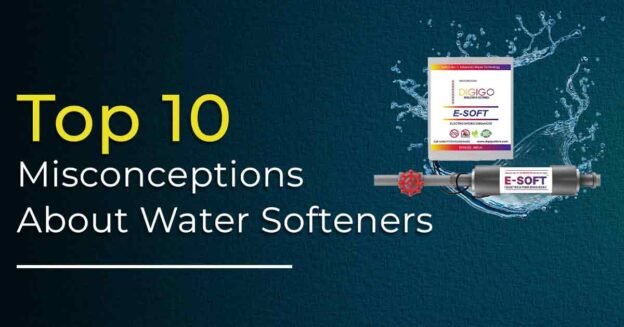When it comes to understanding water softeners, there’s a lot of wrong information out there. Whether you’re thinking about getting a water softener for your home, water softener for industrial business, water softener for your commercial business or for Agriculture or just curious about how they work, you might have heard some common myths that can be confusing. In this blog, we’ll clear up the top 10 misconceptions about water softeners, sharing the facts and helping you make better decisions. Let’s get to the truth and clear up the confusion once and for all!
Contents
- 1 1. Water Softeners Increase Salt Content in the Water
- 2 2. A Lot of Unhealthy Sodium is Added Through Hard Water Softeners
- 3 3. Water Softeners can Purify the Water
- 4 4. Water Softeners can Remove Essential Minerals
- 5 5. Water Softeners Consume More Electricity
- 6 6. Water Softeners are Entitled to Waste More Salt and Water
- 7 7. Water Softener Systems are Quite Expensive
- 8 8. Soft Water from the Water Softener System is Acidic in Nature
- 9 9. The Greatest Misconception is That Water Softeners are Not Required in Urban Areas
- 10 10. Water Softener Systems Remove Harmful Bacteria and Viruses
1. Water Softeners Increase Salt Content in the Water
Many people believe that due to the usage of water softeners, the consumption of salt through water increases, the salt increases in the water, it is a false belief. Water softeners use an ion exchange process to treat hard water. This technique uses a unique medium that is charged with sodium ions. People confuse it with salt and believe that softening water leads to increased salt content in it. However, in reality, it’s not salt that gets added to your water but sodium. We hope that we are able to clear your misconception regarding the salt content in the water due to Water Softeners.
2. A Lot of Unhealthy Sodium is Added Through Hard Water Softeners
The quantity of sodium added to the water entirely depends on how hard your place’s water is. However, you must know that this quantity is too small to have any adverse effects on your health and skin. In fact, the amount of sodium that a water softener adds is quite less as compared to the average intake of the element through dietary sources such as ham, cheese, white bread, and many more. So, next time if someone says that sodium content is higher in Water Softeners you can make their false belief go away.
3. Water Softeners can Purify the Water
Many people believe that Water Softener systems can purify the bad quality of water. This conception is not true. The role of Water Softeners is to remove Hardness from water and not purify it. They are excellent with regards to removing minerals such as calcium and manganese that make the water hard. You must, however, remember that they are not built to remove all the contaminants. They can mostly make water more beneficial but not ideally pure.
4. Water Softeners can Remove Essential Minerals
It is believed that Water Softener systems can remove essential minerals from the water making it less effective, however it is not true. Based on the fact that the equipment can get rid of calcium, iron, and manganese, most people assume that it should not be used. Essentially, these are inorganic minerals that do not benefit you as much as the consumption of foods that contain them. So drinking hard water will not add to the intake of nutrients.
5. Water Softeners Consume More Electricity
This is one of the most common Misconceptions about Water Softeners consume more amount of electricity. However, it is not true, Water Softeners do not consume much electricity. Due to advanced technology, the Water Softeners do not use electricity in high amounts.
6. Water Softeners are Entitled to Waste More Salt and Water
It is one of the top misconceptions that Hard Water softeners tend to waste more salt as well as water. Well we are glad to inform you that it is not true. Water Softeners do not waste salt and water in large proportion, Specially Digigo E-Soft is appreciated as it does not waste a single drop of water, it converts Hard Water into Soft Water directly. Although water softeners use water and salt during the regeneration process which many consider as a waste of resources, it is an essential process that helps the equipment work efficiently. There are several advanced pieces of equipment available that use less electricity, water, and salt.
7. Water Softener Systems are Quite Expensive
A huge amount of people believe that Water Softeners are very expensive and it’s better to not opt for it. It’s not true, in the long run Water Softeners is quite beneficial as it will reduce your electricity, after soft water usage the maintenance cost will be reduced.
8. Soft Water from the Water Softener System is Acidic in Nature
It is believed that Soft Water is acidic in nature, but it is not true. Although water softeners lower the pH level of water, they do not make it acidic enough to have an adverse impact on your body or other appliances.
9. The Greatest Misconception is That Water Softeners are Not Required in Urban Areas
This might be one of the biggest myths of all because even municipal water often contains the minerals that make it hard. In this case, you’ll need a water softener, no matter whether you live in a city or a rural area.
10. Water Softener Systems Remove Harmful Bacteria and Viruses
It is believed that Hard Water Softeners remove bacteria and viruses from Hard water but this is not true. Water softeners are great for removing calcium and magnesium from your water but they will not remove bacteria or viruses.
